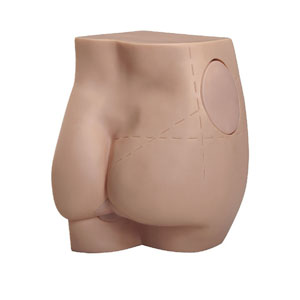27-12-2024
ADA MED SUPPLY LIMITED
Article tag: Hip injection exercise mode BIX-H1T
In medical education, simulation training has always been an effective way to improve the skills of medical staff. Especially in the basic skills of injection operation, wrong operation not only affects the therapeutic effect, but also may bring unnecessary pain and risk to patients. As a common clinical procedure, hip injection requires high precision and skill. So, can the hip injection practice model effectively reduce the error rate in the injection procedure? This is a question worth discussing.
Common errors in injection procedures
The buttock injection procedure usually involves the injection of the gluteus maximus muscle, and the technical requirements include the correct selection of the injection site, Angle, and injection force. Common mistakes include:

1. Inaccurate needle positioning: If the injection site is selected incorrectly, it may lead to injection failure or even injury to nerves or blood vessels.
2. Incorrect injection Angle: Improper injection Angle may cause pain, or the drug cannot enter the muscle tissue correctly.
3. Operation speed is too fast or too slow: Too fast operation may lead to insufficient absorption of the injection fluid, while too slow operation may increase the patient's discomfort.
These errors will not only affect the effect of clinical treatment, but also may lead to discomfort of patients and even complications. Therefore, how to improve injection skills and reduce errors has become an important topic in the training of medical students and clinical staff.
Advantages of simulation training
In modern medical education, simulation training is gradually regarded as an effective way to improve the skills of medical staff. Especially for clinically-based skills such as hip injection manipulation, the hip injection practice model provides a safe and repeatable practice platform that allows students to practice repeatedly in a risk-free environment and gradually improve their skills. Different from the traditional theoretical learning or field operation, the simulation model allows students to master more skills in a short time and correct the mistakes in the operation in time.
1. Improve operation accuracy
Buttock injection practice model is usually highly simulated design, which can truly reproduce the tissue structure of skin, fat layer, muscle and so on. Through this design, students can accurately perceive the level and Angle of needle penetration, so that it is easier to understand and master the correct injection technique. After repeated practice, the student's operating accuracy is greatly improved, and the injection success rate is significantly improved.
2. Reduce learning mistakes
For beginners, the hip injection procedure can go wrong due to nervousness or inexperience. By practicing extensively on simulation models, students can become proficient in injection techniques without fear of harm to patients. Many participants reported a significant improvement in their confidence and proficiency after training with the model, which significantly reduced clinical errors.
3. Enhance clinical resilience
In addition to basic operational skills, the hip injection practice model helps participants develop clinical resilience. In the face of different body types, medical histories and reactions of patients, students can be trained in a targeted manner through simulation models. In this way, not only the injection success rate is improved, but also the additional risk caused by the clinical complex situation can be effectively reduced.
Data support
Several studies have shown that simulation training can significantly improve the operational accuracy of medical students and clinical staff. According to research data in the Journal of Medical Education, participants who used a simulation model to train for hip injections had an error rate of about 40% lower in actual practice (Source: Journal of Medical Education, 2021). In addition, the study found that participants' confidence in patient manipulation increased by more than 30 percent after simulation training. Such data further prove the positive effect of simulation training on reducing injection errors.
conclusion
As an important tool in medical training, hip injection practice model can effectively reduce the injection errors of medical students and beginners in clinical practice. By providing a real hands-on experience and feedback, students are able to master the correct injection technique without risk to the patient. In addition, simulation training can also improve the students' adaptability and self-confidence, and lay a solid foundation for clinical work. Therefore, this model is not only an effective means of upgrading skills, but also provides strong support for medical education and clinical practice.